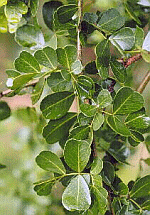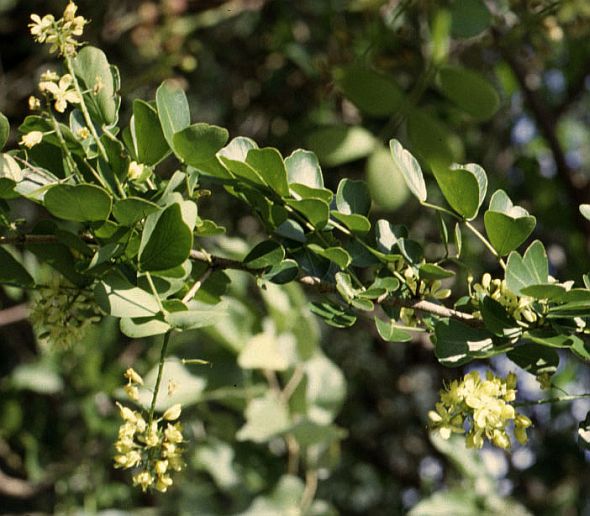

|

Albert Perdeck
Plant Family: Belongs to the Caesalpiniaceae family, which includes Golden Shower (Cassia fistula), Flamboyant (Delonix regia) and Barbados Pride (Caesalpinia pulcherrima); but genus is a small one with only two species, both native to Central America.
Description: Slow growing, small, spiny tree with a broad crown; up to 10 m tall (33 ft); tree trunk and branches thorned, becoming fluted and gnarled with age; wood heavy and extremely hard; leaves usually pinnately compound, 5-10 cm long (2-4 in), with 2-4 pairs of inversely heart-shaped leaflets, 1-3 cm long (0.4-1.2 in); flowers borne in showy axillary racemes, 5-12 cm long (2-5 in), yellow, numerous, quite fragrant and very small, with petals 6-7 mm long (about 0.3 in); blooming December-March; pods are thin, flat and light brown, 3-5 cm long (1-2 in); two varieties - red heartwood and white.
Natural Habitat: Thrives in a hot, rather dry climate; in Dominica, a dominant of dry scrub on west coast to 200 m altitude (650 ft); propagation by seed.
Origin and Distribution: Native to Central America; introduced and widely naturalized in Jamaica and other Caribbean islands, and many South American countries.
Uses: Heartwood and roots of red heartwood variety produce a black-blue or purple dye, used for making ink and for dyeing textiles; Jamaica was a major Logwood exporter, producing until 1942; one of few natural dyes used industrially in US until 1970s, and still used in cottage industry; Logwood honey considered of superior quality; medicinally, bark decoction is effective astringent (drying agent), and is used for treatment of diarrhea; in Mexico, used as remedy for diarrhea, anemia, dysentery, intestinal parasites, tuberculosis, and menstrual disorders; in Brazil, used internally for diarrhea and dysentery; and externally as astringent disinfectant for wounds and skin ulcers; in nineteenth century was used as cure for gangrene.
References:
Campeche (Haematoxylon campechianum). Raintree Tropical Plant Database, Carson City, Nevada, 1999 (raintree.com)
Penelope N. Honeychurch. Caribbean Wild Plants and Their Uses. Macmillan, London, 1986
Dorothy P. Storer. Familiar Trees and Cultivated Plants of Jamaica. Macmillan, London 1964
H.F. Macmillan. Tropical Planting and Gardening. Macmillan, London 1956
C.D. Adams. Flowering Plants of Jamaica. University of the West Indies, Mona, Glasgow University Press 1972
Dan H. Nicolson. Flora of Dominica, Part 2: Dicotyledoneae. Smithsonian Institution, Washington, D.C. 1991
Erin Hammeke. Logwood Dye on Paper. Univ. of Texas, Austin, Texas 2004 (ischool.utexas.edu)
|



